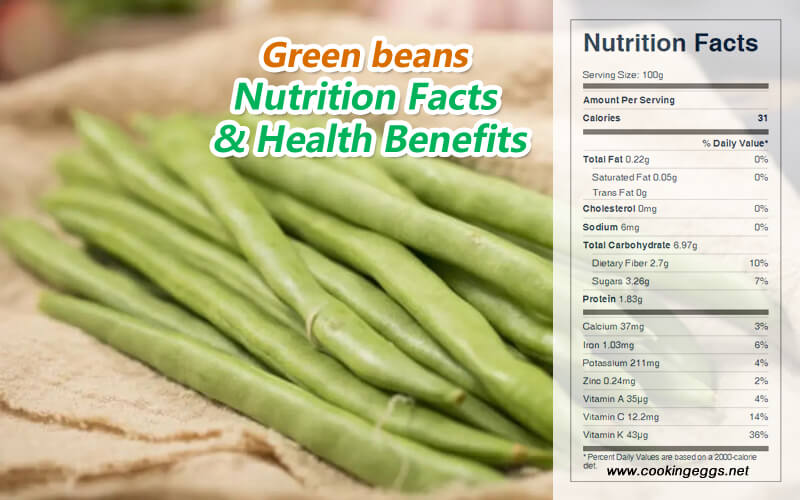Green Beans Nutrition Facts and Health Benefits
Green beans are young, unripe fruits of various cultivars of the common bean. They are known by many common names, including French beans, string beans, and snap beans, or simply snaps.
Green beans are low in calories, high in fiber, and full of nutrients. They provide antioxidant vitamin A and C, as well as vitamin K and the B vitamins thiamine, niacin, riboflavin, and folate. Minerals found in green beans include manganese, potassium, iron, calcium, copper, and phosphorus.
Nutritional Value of Green Beans
Raw green beans are 90% water, 7% carbohydrates, 2% protein, and contain negligible fat. In a 100-gram reference amount, raw green beans supply 31 calories and are a moderate source of vitamin C, vitamin K, vitamin B6, and manganese.
One-half cup of boiled green beans provides 22 calories, 4.9 g carbohydrate, 1.2 g protein, 0.2 g fat, 2 g dietary fiber, 413 IU vitamin A, 6 mg vitamin C, 21 mcg folic acid, 185 mg potassium, 2 mg sodium, 24 mg phosphorus, 29 mg calcium, and 16 mg magnesium.

Raw Green Beans Nutrition Facts Label
Health Benefits of Green beans
Green beans are an excellent source of vitamin K. Research suggests that vitamin K can help to support cardiovascular health and reduce the risk of osteoporosis. Vitamin K has a potential role in the increase of bone mass by promoting osteoblastic activity in the bone.
Studies have confirmed the presence of lutein, beta-carotene, violaxanthin, and neoxanthin in green beans. In some cases, the presence of these carotenoids in green beans is comparable to their presence in other carotenoid-rich vegetables like carrots and tomatoes. The strong carotenoid and flavonoid content of green beans also appears to give this vegetable some potentially unique anti-inflammatory benefits.
In addition to conventional antioxidant nutrients like vitamin C and beta-carotene, green beans contain important amounts of the antioxidant mineral manganese. But the area of phytonutrients is where green beans really shine through in their antioxidant value. Green beans contain a wide variety of carotenoids (including lutein, beta-carotene, violaxanthin, and neoxanthin) and flavonoids (including quercetin, kaemferol, catechins, epicatechins, and procyanidins) that have all been shown to have health-supportive antioxidant properties. For example, green beans have been shown to have greater overall antioxidant capacity than similar foods in the pea and bean families, for example, snow peas or winged beans.
Green beans have also been shown to contain valuable amounts of the mineral silicon, which is very important for bone health and the healthy formation of connective tissue. Green beans have been shown to stack up quite well against other commonly eaten foods as a good source of absorbable silicon.
Green beans have great potential to prevent cancer, heart disease, and other illnesses in which inflammation plays a role. The antioxidant support provided by green beans provides us with some direct cardiovascular benefits. While most of the cardio research on green beans involves animal studies on rats and mice, improvement in levels of blood fats and better protection of these fats from oxygen damage have been shown to result from green bean intake. Interestingly, the green bean pod (the main portion of the green bean that provides the covering for the beans inside) appears to be more closely related to these cardio benefits than the young, immature beans that are found inside.
Like all beans, green beans are loaded with phytonutrients, which may decrease the risk of heart disease and cancer by lowering cholesterol and detoxifying harmful metabolites. While these benefits are related to a host of body processes, one recently studied action is the ability of plants to bind bile salts, thus removing potential toxins from the body. Green beans have demonstrated this beneficial binding ability.
Health Risk
Green beans have measurable amounts of oxalates, so over-consumption can cause problems for those with kidney disease, gout, vulvar pain, rheumatoid arthritis, or other conditions that may require a low-oxalate diet.